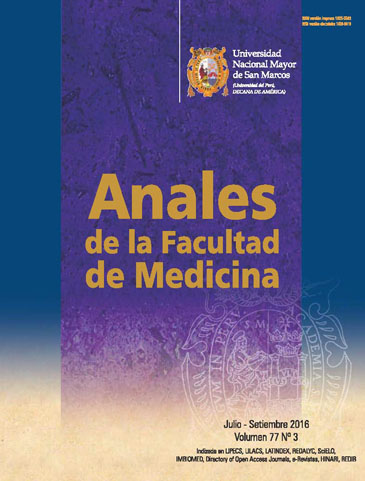Bibliometric analysis of scientific production on research national agenda in Peru 2011-2014
DOI:
https://doi.org/10.15381/anales.v77i3.12410Keywords:
Research Agendas, Bibliometrics, Peru, Research on Health.Abstract
Objectives. To analyze the scientific production framed in the National Research Agenda 2011-2014. Design. Bibliometric research using SCOPUS, LILACS and LIPECS databases. Setting National Health Institute, Lima, Peru. Unit of analysis. Original article with at least one researcher with a Peruvian institution affiliation or whose study population or part of it, came from Peru and framed on any issue of national research agendas. Main outcome measures. Bibliometric indicators of production. Results. Out of the 882 publications retrieved, 215 (24.4%) were admitted to the analysis. The national research agendas with more scientific production were tuberculosis and STD-HIV/AIDS that included 78 and 59 articles respectively. The most common language of publication was English (69.8%). The articles were published in 90 scientific journals. Peruvian institutions with the highest number of signatures were the Universidad Peruana Cayetano Heredia (49.3%), followed by the Ministry of Health (19.5%) and the National Institute of Health (14.4%). The National Institutes of Health (USA) participated in the financing of 50.7% of the articles analyzed. Peruvian institutions that funded more research were the National Institute of Health (4.2%) and the Ministry of Health (2.8%). Conclusions. Peruvian scientific production framed in the six national research agendas in the period 2011-2014 is limited and focused on tuberculosis and STI-HIV / AIDS research; funding was primarily by international institutions.Downloads
Published
2016-10-12
Issue
Section
Artículo Original
License
Copyright (c) 2016 Franco Ronald Romani Romani, Joel Roque Henríquez, Tania Vásquez Loarte, Henry Mormontoy Calvo, Hans Vásquez Soplopuco

This work is licensed under a Creative Commons Attribution-NonCommercial-ShareAlike 4.0 International License.
Those authors who have publications with this magazine accept the following terms:
- Authors will retain their copyrights and guarantee the journal the right of first publication of their work, which will be simultaneously subject to Creative Commons Attribution License that allows third parties to share the work as long as its author and its first publication this magazine are indicated.
- Authors may adopt other non-exclusive licensing agreements for the distribution of the version of the published work (eg, deposit it in an institutional electronic file or publish it in a monographic volume) provided that the initial publication in this magazine is indicated.
- Authors are allowed and recommended to disseminate their work over the Internet (eg: in institutional telematic archives or on their website) before and during the submission process, which It can produce interesting exchanges and increase quotes from the published work. (See El efecto del acceso abierto ).
How to Cite
1.
Romani Romani FR, Roque Henríquez J, Vásquez Loarte T, Mormontoy Calvo H, Vásquez Soplopuco H. Bibliometric analysis of scientific production on research national agenda in Peru 2011-2014. An Fac med [Internet]. 2016 Oct. 12 [cited 2024 Jul. 3];77(3):241-9. Available from: https://revistasinvestigacion.unmsm.edu.pe/index.php/anales/article/view/12410















